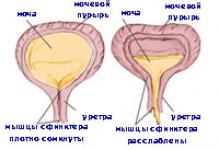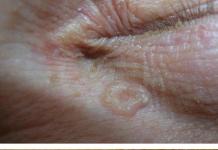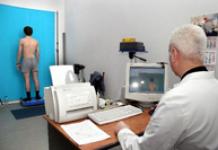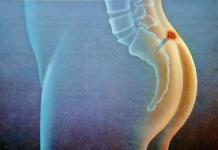2. INVASIVE MONITORING OF BLOOD PRESSURE
Indications
Indications for invasive monitoring blood pressure by catheterization: controlled hypotension; high risk of significant changes in blood pressure during surgery; diseases that require accurate and continuous information about blood pressure for effective hemodynamic management; the need for frequent arterial blood gas testing.
Contraindications
If possible, one should refrain from catheterization if there is no documented evidence of the preservation of collateral blood flow, as well as if there is suspicion of vascular insufficiency(eg, Raynaud's syndrome).
Methodology and complications
A. Selection of artery for catheterization. A number of arteries are available for percutaneous catheterization.
1. The radial artery is catheterized most often, since it is located superficially and has collaterals. However, in 5% of people, the arterial palmar arches are not closed, which makes collateral blood flow inadequate. The Allen test is a simple, although not entirely reliable, way to determine the adequacy of collateral circulation through the ulnar artery in case of radial artery thrombosis. First, the patient vigorously clenches and unclenches his fist several times until the hand turns pale; the fist remains clenched. The anesthesiologist clamps the radial and ulnar arteries, after which the patient unclenches his fist. Collateral blood flow through the arterial palmar arches is considered complete if thumb the brush acquires its original color no later than 5 s after the pressure on the ulnar artery ceases. If restoration of the original color takes 5-10 s, then the test results cannot be interpreted unambiguously (in other words, collateral blood flow is “doubtful”), if more than 10 s, then there is insufficiency of collateral blood flow. Alternative methods for determining arterial blood flow distal to the site of radial artery occlusion include palpation, Doppler, plethysmography, or pulse oximetry. Unlike the Allen test, these methods of assessing collateral blood flow do not require the assistance of the patient.
2. Catheterization of the ulnar artery is technically more difficult to carry out, since it lies deeper and is more tortuous than the radial one. Because of the risk of impaired blood flow in the hand, the ulnar artery should not be catheterized if the ipsilateral radial artery has been punctured but catheterization has not taken place.
3. The brachial artery is large and quite easily identified in cubital fossa. Since along the arterial tree it is located not far from the aorta, the wave configuration is distorted only slightly (compared to the shape pulse wave in the aorta). The proximity of the elbow bend promotes kinking of the catheter.
4. When catheterizing the femoral artery, there is a high risk of the formation of pseudoaneurysms and atheromas, but often only this artery remains accessible in case of extensive burns and severe trauma. Aseptic necrosis of the femoral head is a rare but tragic complication of femoral artery catheterization in children.
5. The dorsal artery of the foot and the posterior tibial artery are located at a considerable distance from the aorta along the arterial tree, so the shape of the pulse wave is significantly distorted. The modified Allen test allows assessment of the adequacy of collateral blood flow before catheterization of these arteries.
6. The axillary artery is surrounded by the axillary plexus, so there is a risk of nerve injury from a needle or from compression by a hematoma. When flushing the catheter installed in the left axillary artery, air and blood clots will quickly enter the vessels of the brain.
B. Technique for catheterization of the radial artery.
Supination and extension of the hand provide optimal access to the radial artery. You should first assemble the catheter-line-transducer system and fill it with a heparinized solution (approximately 0.5-1 units of heparin for each ml of solution), i.e., prepare the system for quick connection after catheterization of the artery.
By superficial palpation with the tips of the index and middle fingers of the non-dominant hand, the anesthesiologist determines the pulse on the radial artery and its location, focusing on the sensation of maximum pulsation. The skin is treated with iodoform and an alcohol solution and 0.5 ml of lidocaine is infiltrated into the artery projection through a 25-27 gauge needle. A Teflon catheter on a 20-22 gauge needle is used to pierce the skin at an angle of 45°, after which it is advanced towards the pulsation point. When blood appears in the pavilion, the needle injection angle is reduced to 30° and, for reliability, moved forward another 2 mm into the lumen of the artery. The catheter is inserted into the artery using a needle, which is then removed. When connecting the line, the artery is compressed with the middle and ring fingers proximal to the catheter to prevent the release of blood. The catheter is fixed to the skin with a waterproof adhesive tape or sutures.
B. Complications. Complications of intra-arterial monitoring include hematoma, arterial spasm, arterial thrombosis, air embolism and thromboembolism, necrosis of the skin over the catheter, nerve damage, infection, loss of fingers (due to ischemic necrosis), and inadvertent intra-arterial drug administration. Risk factors include prolonged catheterization, hyperlipidemia, multiple attempts at catheterization, being female, the use of extracorporeal circulation, and the use of vasopressors. The risk of complications is reduced by such measures as reducing the diameter of the catheter in relation to the lumen of the artery, constant maintenance infusion of heparin solution at a rate of 2-3 ml/h, reducing the frequency of catheter jet rinses and careful asepsis. The adequacy of perfusion during radial artery cannulation can be continuously monitored by pulse oximetry by placing a sensor on the index finger of the ipsilateral hand.
Because intra-arterial catheterization provides long-term and continuous measurement of arterial pressure, it is considered the gold standard for blood pressure monitoring. At the same time, the quality of pulse wave conversion depends on the dynamic characteristics of the catheter-line-transducer system. An error in blood pressure measurement results may result in prescription improper treatment.
The pulse wave is mathematically complex; it can be represented as the sum of simple sine and cosine waves. The technique of converting a complex wave into several simple ones is called Fourier analysis. For the conversion results to be reliable, the catheter-line-transducer system must adequately respond to the highest frequency oscillations of the arterial pulse wave. In other words, the natural frequency of oscillation of the measuring system should exceed the frequency of oscillation of the arterial pulse (approximately 16-24 Hz).
In addition, the catheter-line-transducer system must prevent the hyperresonance effect resulting from the reverberation of waves in the lumen of the system tubes. The optimal dumping coefficient (β) is 0.6-0.7. The dumping coefficient and the natural frequency of oscillations of the catheter-line-transducer system can be calculated by analyzing the oscillation curves obtained when flushing the system under high pressure.
Reducing the length and extensibility of tubes, removing unnecessary shut-off valves, preventing the appearance of air bubbles - all these measures improve the dynamic properties of the system. Although small bore intravascular catheters reduce the natural oscillation frequency, they provide improved system performance with a low damping coefficient and reduce the risk of vascular complications. If a large-diameter catheter occludes the artery completely, the reflection of waves leads to errors in blood pressure measurement.
Pressure transducers have evolved from bulky, reusable devices to miniature, disposable sensors. The transducer converts the mechanical energy of pressure waves into an electrical signal. Most converters are based on the principle of voltage measurement: stretching a wire or silicon crystal changes its electrical resistance. The sensing elements are arranged as a resistance bridge circuit, so the output voltage is proportional to the pressure acting on the diaphragm.
The accuracy of blood pressure measurement depends on the correct calibration and zeroing procedure. The transducer is installed at the desired level - usually this is the mid-axillary line, the stop valve is opened, and a zero blood pressure value is displayed on the monitor that is turned on. If during the operation the position of the patient is changed (when the height of the operating table is changed), then the transducer must be moved simultaneously with the patient or reset to the zero value at a new level of the mid-axillary line. In a sitting position, blood pressure in the vessels of the brain differs significantly from the pressure in the left ventricle of the heart. Therefore, in a sitting position, blood pressure in the vessels of the brain is determined by setting the zero value at the level of the external auditory canal, which approximately corresponds to the level of the circle of Willis (the arterial circle of the cerebrum). The transmitter should be regularly checked for zero drift, a deviation caused by temperature changes.
External calibration consists of comparing the pressure values of the transducer with the data of a mercury manometer. The measurement error should be within 5%; if the error is greater, the monitor amplifier should be adjusted. Modern transmitters rarely require external calibration.
Digital values of ADsyst. and ADdiast. are the average values, respectively, of the highest and lowest blood pressure values over a certain period of time. Since random movement or operation of the electrocautery can distort blood pressure values, monitoring of the pulse wave configuration is necessary. Pulse wave configuration provides valuable hemodynamic information. Thus, the steepness of the ascending leg of the pulse wave characterizes myocardial contractility, the steepness of the descent of the descending leg of the pulse wave is determined by the total peripheral vascular resistance, and significant variability in the size of the pulse wave depending on the respiratory phase indicates hypovolemia. ADvg value calculated by integrating the area under the curve.
Intra-arterial catheters provide the ability to frequently analyze arterial blood gases.
Recently, a new development has emerged - a fiber-optic sensor inserted into the artery through a 20-gauge catheter and designed for long-term continuous monitoring of blood gases. High-energy light is transmitted through an optical sensor, the tip of which has a fluorescent coating. As a result, the fluorescent dye emits light whose wave characteristics (wavelength and intensity) depend on pH, PCO 2 and PO 2 (optical fluorescence). The monitor detects changes in fluorescence and displays the corresponding blood gas values on the display. Unfortunately, the cost of these sensors is high.
LITERATURE
1. "Urgent" health care", ed. J.E. Tintinally, Rl. Kroma, E. Ruiz, Translated from English doctor honey. Sciences V.I.Kandrora, Doctor of Medical Sciences M.V. Neverova, Dr. med. Sciences A.V. Suchkova, Ph.D. A.V. Nizovoy, Yu.L. Amchenkova; edited by Doctor of Medical Sciences V.T. Ivashkina, D.M.N. P.G. Bryusova; Moscow "Medicine" 2001
2. Intensive therapy. Resuscitation. First aid: Tutorial/ Ed. V.D. Malysheva. - M.: Medicine. - 2000. - 464 p.: ill. - Textbook. lit. For students of the postgraduate education system. - ISBN 5-225-04560-Х
Depending on the patient’s condition, and in case of a positive decision, he must appoint a person temporarily responsible for administering anesthesia. STANDARD Il During anesthesia, it is necessary to periodically monitor oxygenation, ventilation, circulation and body temperature of the patient. OXYGENATION Purpose: To ensure adequate concentration of oxygen in the inhaled mixture and in the blood during anesthesia. ...
Fabrics. The advent of conjunctival oxygen sensors, which can non-invasively determine arterial pH, may revive interest in this technique. 3. Anesthetic gas monitoring Indications Anesthetic gas monitoring provides valuable information when general anesthesia. Contraindications There are no contraindications, although the high cost limits the procedure...
Information about important hemodynamic parameters can reduce the risk of developing certain perioperative complications (for example, myocardial ischemia, heart failure, renal failure, pulmonary edema). In critical illness, monitoring pulmonary artery pressure and cardiac output provides more accurate information about the circulatory system than physical examination. ...
And high total peripheral vascular resistance. Effective pharmacologic manipulation of preload, afterload, and contractility is impossible without accurate measurement of cardiac output. 2. RESPIRATION MONITORING Precordial and esophageal stethoscopes Indications Most anesthesiologists believe that during anesthesia in all patients they should be used for monitoring...
A needle or cannula connected by a tube to a pressure gauge is inserted directly into the artery.
Auscultatory method by N. S. Korotkov.
The auccultative method is the most widespread and is based on establishing systolic and diastolic pressure by the appearance and disappearance of special sound phenomena in the artery that characterize the turbulence of blood flow - Korotkoff sounds.
Oscillometric method.
The method is based on the fact that when blood passes during systole through a compressed section of the artery in the cuff, micropulsations of air pressure occur, by analyzing which it is possible to obtain the values of systolic, diastolic and average pressure.
Normal blood pressure indicators:
Systolic blood pressure – 100-139 mm. rt. Art.
Diastolic blood pressure is 60-89 mm. rt. Art.
Factors influencing blood pressure:
Stroke blood volume
Minute blood volume
Total peripheral resistance
Circulating blood volume
Venous pressure is the pressure of blood in the right atrium.
Factors influencing the value of VD:
Circulating blood volume
Venous return
Myocardial contractility
Factors involved in the formation of venous return.
2 groups of factors:
Group 1 is represented by factors that are united by the general term “vis a tegro”, acting from behind.
13% of the energy imparted to the blood flow by the heart;
Contraction of skeletal muscles (“muscle heart”, “muscle venous pump”);
The transition of fluid from tissue to blood in the venous part of the capillaries;
The presence of valves in large veins prevents the reverse flow of blood;
Constrictor (contractile) reactions of venous vessels to nervous and humoral influences.
Group 2 is represented by factors that are united by the general term “vis a fronte”, acting from the front:
Suction function chest.
When inhaling, the negative pressure in the pleural cavity increases and this leads to a decrease in central venous pressure (CVP) and an acceleration of blood flow in the veins.
Suction function of the heart.
It is carried out by reducing the pressure in the right atrium (CVP) to zero in diastole.
Blood pressure recording curve:
First-order waves are fluctuations in blood pressure caused by systole and diastole. If the recording is carried out for a sufficiently long time, then 2nd and 3rd order waves can be recorded on the kymograph. Second-order waves are fluctuations in blood pressure associated with the act of inhalation and exhalation. Inhalation is accompanied by a decrease in blood pressure, and exhalation is accompanied by an increase. 3rd order waves are caused by changes in blood pressure over approximately 10-30 minutes - these are slow fluctuations. These waves reflect fluctuations in vascular tone, which arise as a result of changes in the tone of the vasomotor center.
- Functional classification of parts of the vascular bed. Factors that ensure blood movement through high and low pressure vessels.
Functional classification of vessels.
1. Elastically extensible (aorta and pulmonary artery), vessels of the “boiler” or “compression chamber”. Vessels are elastic type, receiving a portion of blood due to stretching of the walls. They provide a continuous, pulsating blood flow, form dynamic systolic and pulse pressure in the systemic and pulmonary circulation, and determine the nature of the pulse wave.
2. Transient (large, medium arteries and large veins). Vessels are of the muscular-elastic type, almost not subject to nervous and humoral influences, and do not affect the nature of blood flow.
3. Resistive (small arteries, arterioles and venules). Muscular-type vessels make the main contribution to the formation of resistance to blood flow and significantly change their lumen under the influence of nervous and humoral influences.
4. Exchange (capillaries). In these vessels, exchange occurs between blood and tissues.
5. Capacitive (small and medium veins). Vessels that contain the bulk of blood. They respond well to nervous and humoral influences. Ensure adequate blood return to the heart. Change in pressure in the veins by several mmHg. increases the amount of blood in capacitance vessels by 2-3 times.
6. Bypass (arteriovenous anastomoses). They ensure the transition of blood from the arterial system to the venous system, bypassing the exchange vessels.
7. Sphincter vessels (precapillary and postcapillary). The zonal switching on and off of metabolic vessels in the bloodstream is determined.
The movement of blood through the arteries is determined by the following factors:
1. The work of the heart, which ensures the replenishment of energy costs of the circulatory system.
2. The elasticity of the walls of elastic vessels. During systole, the energy of the systolic portion of blood transforms into the energy of deformation of the vascular wall. During diastole, the wall contracts and its potential energy turns into kinetic energy. This helps maintain lower blood pressure and smooth out pulsations of arterial blood flow.
3. Pressure difference at the beginning and end of the vascular bed. It occurs as a result of the expenditure of energy to overcome resistance to blood flow.
The walls of veins are thinner and more stretchable than those of arteries. The energy of heart contractions has already been largely spent on overcoming the resistance of the arterial bed. Therefore, the pressure in the veins is low and additional mechanisms are required to promote venous return to the heart. Venous blood flow is provided by the following factors:
1. Pressure difference at the beginning and end of the venous bed.
2. Contractions of skeletal muscles during movement, as a result of which blood is pushed from the peripheral veins to the right atrium.
3. Suction action of the chest. On inspiration, the pressure in it becomes negative, which promotes venous blood flow.
4. Suction action of the right atrium during its diastole. The expansion of its cavity leads to the appearance of negative pressure in it.
5. Contractions of smooth muscles of veins.
The movement of blood through the veins to the heart is also due to the fact that they have protrusions of the walls that act as valves.
- Capillary blood flow and its features. Microcirculation and its role in the mechanism of exchange of fluid and various substances between blood and tissues.
Microcirculation is the transport of biological fluids at the tissue level. The set of all vessels providing microcirculation is called the microvasculature and includes arterioles, precapillaries, capillaries, postcapillaries, venules, arteriole-venular anastomoses, lymphatic capillaries.
Blood flow in this section of the circulation ensures its leading function - exchange between blood and tissues. That is why the main link in this system, the capillaries, is called exchange vessels. Their function is closely related to the vessels from which they begin - arterioles and the vessels into which they pass - venules. There are direct arteriovenous anastomoses connecting them, bypassing the capillaries. If we add lymphocapillaries to this group of vessels, then all this together will form what is called the microcirculation system. This is the most important part of the circulatory system. It is in it that the disorders that cause the bulk of diseases occur. The basis of this system is capillaries. Normally, at rest, only 25-35% of the capillaries are open; if many of them open at once, then hemorrhage occurs in the capillaries and the body may even die from internal blood loss, since blood accumulates in the capillaries and does not flow to the heart.
Capillaries pass in the intercellular spaces and, therefore, the exchange of substances occurs between the blood and the intercellular fluid. Factors that contribute to this: the difference in hydrostatic pressure at the beginning and end of the capillary (30-40 mm Hg and 10 mm Hg), blood speed (0.05 m/s), filtration pressure (difference between hydrostatic pressure in the interstitial fluid – 15 mm Hg) and reabsorption pressure (the difference between the hydrostatic pressure at the venous end of the capillary and oncotic pressure in the interstitial fluid – 15 mm Hg). If these ratios change, then the liquid flows predominantly in one direction or another.
Filtration pressure is calculated using the formula FD=GD-OD, or rather FD = (GD cr - GD tk) - (OK cr - OD tk).
Volumetric rate of transcapillary exchange (ml/min) can be represented as:
V=K filter /(GD cr -GD tk)-K osm (OD cr -OD tk), Where K filter– capillary filtration coefficient, reflecting the exchange surface area (the number of functioning capillaries) and the permeability of the capillary wall for liquid , To osm- osmotic coefficient , reflecting the actual permeability of the membrane to electrolytes and proteins.
Diffusion is the penetration of substances through a membrane; movement of a solute from an area of higher concentration to an area of lower concentration.
Osmosis is a type of transport in which a solvent moves from an area of lower concentration to an area of higher concentration.
Filtration is a type of transport in which the transfer of a substance occurs through fenestrae (“windows” in capillaries, which are holes piercing the cytoplasm with a diameter of 40-60 nm, formed by a very thin membrane) or through gaps between cells.
Active transport - with the help of small carriers, with the expenditure of energy. Thus, individual amino acids, carbohydrates and other substances are transported. Active transport is often associated with Na+ transport. That is, the substance forms a complex with a Na+ carrier molecule.
- Lymphatic system. Functions of lymph. Lymph formation, its mechanism. Features of the regulation of lymph formation and lymph drainage.
Lymphatic system (lat. systema lymphaticum) - part vascular system in vertebrates, complementing the cardiovascular system. It plays an important role in metabolism and cleansing of body cells and tissues. Unlike the circulatory system, the mammalian lymphatic system is open-ended and does not have a central pump. The lymph circulating in it moves slowly and under low pressure.
Lymph consists of lymphoplasm and formed elements (ions K, Na, Ca, Cl, etc.), and there are very few cells in the peripheral lymph, and significantly more in the central lymph.
Lymph performs or participates in the implementation of the following functions:
1) maintaining a constant composition and volume of interstitial fluid and cell microenvironment;
2) return of protein from the tissue environment to the blood;
3) participation in the redistribution of fluid in the body;
4) ensuring humoral communication between tissues and organs, the lymphoid system and blood;
5) absorption and transport of food hydrolysis products, especially lipids from gastrointestinal tract into the blood;
6) providing immunity mechanisms by transporting antigens and antibodies, transferring plasma cells, immune lymphocytes and macrophages from lymphoid organs.
Lymph formation.
As a result of plasma filtration in the blood capillaries, the liquid enters the intercellular (interstitial) space, where water and electrolytes partially bind to colloidal and fibrous structures and partially form the aqueous phase. This creates tissue fluid, part of which is reabsorbed back into the blood, and part of which enters the lymphatic capillaries, forming lymph. Thus, lymph is the space of the internal environment of the body, formed from intercellular fluid. The formation and outflow of lymph from the intercellular space are subject to the forces of hydrostatic and oncotic pressure and occur rhythmically.
Lymph node (lymph node)- a peripheral organ of the lymphatic system that functions as a biological filter through which lymph flows from organs and parts of the body. The lymph nodes perform the function of lymphocytopoiesis, barrier-filtration, immunological function.
Factors ensuring lymph movement:
The invasive (direct) method of measuring blood pressure is used only in inpatient conditions during surgical interventions, when insertion of a probe with a pressure sensor into the patient’s artery is necessary for continuous monitoring of the pressure level.
The sensor is inserted directly into the artery. , Direct manometry is practically the only method for measuring pressure in the cavities of the heart and central vessels. The advantage of this method is that the pressure is measured continuously, displayed as a pressure/time curve. However, patients with invasive blood pressure monitoring require constant monitoring due to the risk of severe bleeding in case of probe disconnection, hematoma formation or thrombosis at the puncture site, or infectious complications.
Blood flow speed
Blood flow speed, along with blood pressure, is the main physical quantity characterizing the state of the circulatory system.
There are linear and volumetric blood flow speeds. Linear blood flow velocity (V-lin) is the distance that a blood particle travels per unit time. It depends on the total cross-sectional area of all vessels forming a section of the vascular bed. Therefore, the widest section of the circulatory system is the aorta. Here the highest linear speed of blood flow is 0.5-0.6 m/sec. In arteries of medium and small caliber it decreases to 0.2-0.4 m/sec. The total lumen of the capillary bed is 500-600 times less than that of the aorta, so the speed of blood flow in the capillaries decreases to 0.5 mm/sec. Slowing down the blood flow in the capillaries is of great physiological importance, since transcapillary exchange occurs in them. In large veins, the linear speed of blood flow increases again to 0.1-0.2 m/sec. The linear velocity of blood flow in the arteries is measured by ultrasound. It is based on the Doppler effect. A sensor with an ultrasound source and receiver will be placed on the vessel. In a moving medium - blood, the frequency of ultrasonic vibrations changes. The higher the speed of blood flow through the vessel, the lower the frequency of reflected ultrasonic waves. The speed of blood flow in the capillaries is measured under a microscope with divisions in the eyepiece, by observing the movement of a specific red blood cell.
Volumetric blood flow velocity (volume) is the amount of blood passing through the cross section of a vessel per unit time. It depends on the pressure difference at the beginning and end of the vessel and the resistance to blood flow. In the clinic, volumetric blood flow is assessed using rheovasography. This method is based on recording fluctuations in the electrical resistance of organs to high-frequency current when their blood supply changes during systole and diastole. With an increase in blood supply, the resistance decreases, and with a decrease it increases. For diagnostic purposes vascular diseases perform rheovasography of the limbs, liver, kidneys, and chest. Plethysmography is sometimes used. This is a registration of fluctuations in organ volume that occur when their blood supply changes. Volume fluctuations are recorded using water, air and electrical plethysmographs.
When conducting seriously ill patients, as well as patients with unstable hemodynamics to assess the condition of cardio-vascular system and the effectiveness of therapeutic interventions, there is a need for constant recording of hemodynamic parameters.
Direct blood pressure measurements carried out through a catheter or cannula inserted into the lumen of the artery. Direct access is used both for continuous recording of blood pressure and for taking samples of the gas composition and acid-base state of the blood. Indications for arterial catheterization include unstable blood pressure and infusion of vasoactive drugs.
Most common accesses for insertion of an arterial catheter are the radial and femoral arteries. The brachial, axillary or foot arteries are used much less frequently. When choosing access, the following factors are taken into account:
correspondence of the diameter of the artery to the diameter of the cannula;
The catheterization site must be accessible and free from body secretions;
the limb distal to the catheter insertion site must have sufficient collateral blood flow, since there is always the possibility of arterial occlusion.
More often use the radial artery, since it has a superficial location and is easily palpated. In addition, its cannulation is associated with the least restriction of the patient's mobility.
To avoid complications, it is preferable to use arterial cannulas rather than arterial catheters.
Before radial artery cannulation Allen's test is performed. To do this, the radial and ulnar arteries are clamped. Then the patient is asked to clench and unclench his fist several times until the hand turns pale. The ulnar artery is released and the restoration of the color of the hand is observed. If it is restored within 5-7 s, blood flow through the ulnar artery is considered adequate. A time ranging from 7 to 15 s indicates a violation of blood circulation in the ulnar artery. If the color of the limb is restored after more than 15 s, radial artery cannulation is abandoned.
Artery cannulation performed under sterile conditions. The system for measuring blood pressure is pre-filled with solution and the strain gauge is calibrated. To fill and flush the system, use a saline solution to which 5000 units of heparin are added.
Invasive BP monitoring provides continuous measurement of this parameter in real time, but when interpreting the information received, a number of limitations and errors are possible. First of all, the shape of the blood pressure curve obtained in the peripheral artery does not always accurately reflect that in the aorta and other great vessels. The shape of the BP waveform is influenced by left ventricular inotropic function, aortic and peripheral vascular resistance, and the characteristics of the BP monitoring system. The monitor system itself can cause various artifacts, as a result of which the shape of the blood pressure curve changes. Correct interpretation of information obtained through invasive monitoring requires some experience. Here we should point out the need to recognize unreliable data. This is important because incorrect analysis and incorrect interpretation of the data obtained can lead to incorrect medical decisions.
Measuring blood pressure using an invasive method is one of the most accurate types of monitoring of systemic hemodynamics, which allows real-time monitoring of fluctuations in both blood pressure and the state of peripheral circulation. Thanks to the emergence and spread of modern monitors, IBP measurement is gradually becoming part of routine clinical practice in the CIS countries, and in Western Europe and the USA it is no longer something out of the ordinary. The widespread use of modern disposable consumables makes the process of arterial catheterization and setting up IBP monitoring convenient for the doctor and the patient.
The general scheme for measuring invasive blood pressure looks like this: pulse wave oscillations are transmitted through an arterial catheter to a transducer, which is connected directly to the iBP sensor. The sensor transmits readings to the monitor, which displays the IBP curve, the direct numerical value of this indicator, as well as the pulse rate. The value of iBP depends not only on the pressure in the artery, but also on the location of the sensor relative to the level of the patient’s right atrium. Similarly, central venous pressure can be monitored in real time; in this case, the system is connected to a catheter located in the superior or inferior vena cava.
Indications for the use of invasive blood pressure monitoring in clinical practice are quite diverse, but most often include:
- Surgical interventions accompanied by significant fluctuations in systemic hemodynamics (cardiac surgery, vascular surgery, transplantology, neurosurgery, etc.);
- Surgical interventions in patients with a high risk of destabilization of systemic hemodynamics (heart defects, severe hypovolemia, patients after a major myocardial infarction, etc.);
- Selected interventions in which real-time blood pressure monitoring is very important (carotid endarterectomy, surgery for intracranial aneurysms);
- Use of long-term mono- and polycomponent vasopressor and inotropic support in the intensive care unit;
- Management of patients with pre- and eclampsia in obstetric practice.
The site of choice for catheter placement for invasive blood pressure measurement is usually the radial artery. The use of ulnar or femoral arteries carries the risk of necrosis of the distal limb, so their use is recommended only in extreme cases and for a short time. Routine use of the Allen test before arterial catheterization is currently not recommended due to its low predictive value. Special arterial catheters with a lock that have optimal rigidity are best suited for catheterization of arteries, but it is also possible to use standard intravenous catheters. Both the catheter-on-a-needle technique and the Seldinger technique can be used. The puncture site is carefully treated, the catheter is filled with heparin solution. It is best to make the injection at an angle of 45 degrees relative to the axis of the artery, then changing the direction to a flatter one after hitting the artery. After catheterization, a heparin flush system should be immediately connected (2500 units of unfractionated heparin per 500 ml isotonic solution sodium chloride) to prevent catheter thrombosis, which occurs very quickly. The irrigation system usually includes a container of irrigation solution, which can be administered either as a bolus or as a continuous infusion using a syringe pump. The transducer is connected to an invasive blood pressure sensor connected to the monitor.

Next, the so-called zero setting is carried out - the reference point for recording indicators. To do this, the arterial line is blocked, the sensor-transducer system is placed at the level of the patient’s right atrium, and the corresponding item is pressed on the monitor. After this, the indicators are updated. The arterial line is then opened and blood pressure recording begins.
During the measurement process, it is necessary to ensure that there is no significant reflux of blood from the artery into the connecting tube extending from the catheter. In this case, it is necessary to immediately flush the catheter with a bolus of rinsing solution. It is also necessary to monitor the level of the transducer; most often it is fixed on a special stand using a tablet.
Given the risk of thromboembolic complications, the catheter should be in the artery only for the time during which IBP monitoring is necessary. At the end of the measurement, the arterial catheter is removed and a pressure bandage is applied.


























